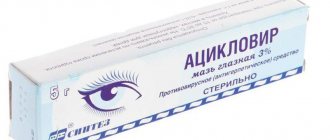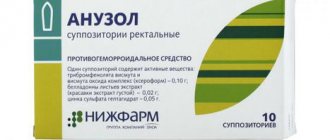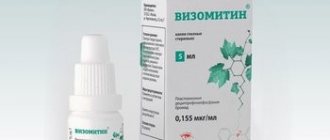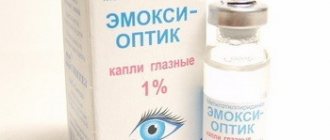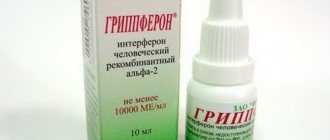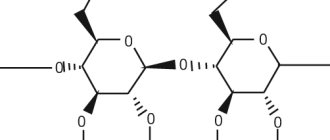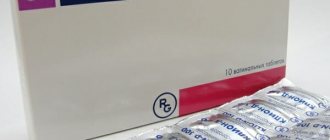The drug Nimulid belongs to the group of non-steroidal anti-inflammatory medicinal compounds. Used to reduce the intensity of inflammatory reactions accompanied by acute pain syndrome in various lesions of the musculoskeletal system. The drug is highly effective and safe. The active ingredient in the drug is Nimesulide. The drug has a limited list of indications and high safety indicators.
Description and composition
Nimulid tablets have a smooth surface, round shape, and are colored yellow. The main active component is Nimesulide, its dose in one tablet is 100 milligrams. The drug also contains auxiliary components, namely:
- lactose monohydrate;
- colloidal silicon dioxide;
- povidone;
- sodium dioxide;
- croscarmellose sodium;
- corn starch;
- lactose;
- polysorbate.
The listed components provide the required dosage form and often act as a preservative.
Pharmacological group
The main active substance of the drug Nimulid is nimesulide, which, according to its chemical derivative, belongs to the class of sulfonamides. The drug inhibits the production of the main mediators of the inflammatory response and prostaglandins from sugar acid. This reaction is achieved by inhibiting the enzyme cyclooxygenase. By reducing the concentration of prostaglandins in the area of the inflammatory process, swelling and pain are eliminated.
Unlike other non-steroidal anti-inflammatory drugs, Nimesulide acts selectively, inhibiting almost cyclooxygenases, with virtually no effect on the activity of tsog-1. The drug does not have a negative effect on the level of prostaglandins located on the gastric mucosa. Also, the drug does not affect the ability of platelets to form a blood clot due to its aggregation. That is why the drug Nimesulide is less likely to provoke adverse reactions from the digestive system and blood coagulation system.
Immediately after oral administration of the drug, Nimulid and its active substance are fully and quickly absorbed into the systemic circulation from the intestinal lumen. The composition is well and quickly distributed in tissues with high accumulation in an acidic environment. Metabolism of the drug component is ensured in liver cells. In the process, inactive decay products are formed, which are excreted from the human body with urine and bile. The half-life is up to 5 hours.
Nilide Comp. film. 100 mg N20
M01A X17 - Anti-inflammatory/anti-rheumatic
Pharmacological properties
A non-steroidal anti-inflammatory drug that also has analgesic and antipyretic effects. In the body it is converted into hydroxynimesulide, which is the active form of the drug. The mechanism of action is primarily inhibition of cyclooxygenase-2 and blockade of prostaglandin synthesis. Delays the formation of free radicals. Does not affect hemostasis and phagocytosis. Inhibits the release of myeloperoxidase. Bound by plasma proteins up to 99%.
Indications
Osteoarthritis, including rheumatic arthritis, osteoarthritis, bursitis, tendonitis; pain syndrome of various etiologies, including gynecological diseases, postoperative period, injuries; febrile conditions in infectious diseases.
Mode of application
100 mg 2 times a day after meals. The granules from the bag are dissolved in 1/2 cup of water.
Overdose
Cases of overdose have not been described. There is no specific antidote. Dialysis is not recommended (the drug is bound to plasma proteins).
Side effects
Nausea, heartburn, stomach pain, headaches, dizziness, skin rashes. Side effects are rare, mild in intensity, transient and do not require cessation of treatment.
Contraindications
Active peptic ulcer, severe liver failure, renal failure with creatinine clearance less than 30 ml/min, hypersensitivity to the drug.
Interaction
May displace other drugs from plasma proteins. There were no special interactions of nimesulide with furosemide, warfarin, digoxin, theophylline, glibenclamide, cimetidine and antacids.
special instructions
It is not recommended in the third trimester of pregnancy, as it can accelerate the closure of the ductus botallus in the fetus and cause atony of the uterine muscle in the mother. During treatment of a nursing mother, the child should be switched to artificial feeding.
Specialităţi
Mesulid (Sanofi-Winthrop Industrie, Franţa)
Prezentare: Comprimate 100 mg N 30. Termen de valabilitate: 5 ani. Condiţii de conservare: Temperature camerei. Sl. Cu prescripţie medicală.
Mesulid (Sanofi-Winthrop Industrie, Franţa)
Prezentare: Suspensie buvabilă 1%-200 ml in flacoane cu linguriţă 10 ml. Termen de valabilitate: 4 ani. Condiţii de conservare: Temperature camerei. Sl. Cu prescripţie medicală.
Mesulid (Sanofi-Winthrop Industrie, Franţa)
Prezentare: Supozitoare 200 mg N 10. Termen de valabilitate: 5 ani. Condiţii de conservare: Temperature camerei. Sl. Cu prescripţie medicală.
Mesulid (Sanofi-Winthrop Industrie, Franţa)
Prezentare: Granule 100 mg in plicuri N 30. Termen de valabilitate: 5 ani. Condiţii de conservare: Temperature camerei. Sl. Cu prescripţie medicală.
Mesulid (Helsinn Birex Therapeutics Ltd, Ireland)
Prezentare: Comprimate 100 mg N 10 şi N 15. Termen de valabilitate: 5 ani. Condiţii de conservare: Temperature camerei. Statutul legal: Cu prescripţie medicală.
Nilide (Cadila Pharmaceuticals Ltd, India)
Prezentare: Comprimate filmate 100 mg N Termen de valabilitate: Condiţii de conservare: Loc uscat, răcoros, ferit de lumină. Statutul legal: Cu prescripţie medicală.
Nimegesic (Alembic Ltd., India)
Prezentare: Suspensie buvabilă 50 mg/5 ml 60 ml. Termen de valabilitate: 3 ani. Condiţii de conservare: Loc uscat, răcoros, ferit de lumină. Statutul legal: Cu prescripţie medicală.
Nimegesic-100 (Alembic Ltd, India)
Prezentare: Comprimate 100 mg N 10. Termen de valabilitate: 3 ani. Condiţii de conservare: Temperature 15-250 C, ferit de umiditate şi lumină. Sl. Cu prescripţie medicală.
Nimegesic T (Alembic Ltd, India)
Prezentare: Gel transdermal 1% 30 g. Termen de valabilitate: 2 ani. Condiţii de conservare: Loc uscat, răcoros, ferit de lumină. Statutul legal: Cu prescripţie medicală.
Nimelid 100 mg (Magistra C&C Constanta, România)
Prezentare: Comprimate 100 mg N 10. Termen de valabilitate: 2 ani. Condiţii de conservare: Loc uscat, răcoros, ferit de lumină. Statutul legal: Cu prescripţie medicală.
Nimesil (Laboratori Guidotti, Italy)
Prezentare: Granule pentru prepararea suspensiei buvabile 100 mg/2 g in pacheţele N 30. Termen de valabilitate: 2 ani. Condiţii de conservare: Loc uscat, răcoros, ferit de lumină. Sl. Cu prescripţie medicală.
Nimesulid (Intermed, India)
Prezentare: Comprimate 100 mg N 10 şi N 100 în blistere. Termen de valabilitate: 3 ani. Condiţii de conservare: Temperatura 8-150 C, loc uscat, ferit de lumină. Statutul legal: Cu prescripţie medicală.
Nimez-100 (Plethico Pharmaceuticals Ltd, India)
Prezentare: Comprimate 100 mg N 10. Termen de valabilitate: 5 ani. Condiţii de conservare: Temperatura 15-250 C. Statutul legal: Cu prescripţie medicală.
Nimez Effertabs (Plethico Pharmaceuticals Ltd, India)
Prezentare: Comprimate efervescente 100 mg N 4. Termen de valabilitate: 3 ani. Condiţii de conservare: Temperatura camerei (15-250 C), loc uscat, ferit de lumină. Statutul legal: Cu prescripţie medicală.
Nimez Suspension (Plethico Pharmaceuticals Ltd, India)
Prezentare: Suspensie buvabilă 50 mg/5 ml – 60 ml. Termen de valabilitate: 3 ani. Condiţii de conservare: Temperatura 15-250 C. Statutul legal: Cu prescripţie medicală.
Nimosol-100 (West-Coast Pharmaceutical Works, India)
Prezentare: Comprimate 100 mg N 10 in blister. Termen de valabilitate: 4 ani. Condiţii de conservare: Loc uscat, răcoros, ferit de lumină. Statutul legal: Cu prescripţie medicală.
Oestolide 100 mg tablets (Biomedicare PVT Ltd, India)
Prezentare: Comprimate filmate 100 mg N 10 şi N 30. Termen de valabilitate: 5 ani. Condiţii de conservare: Loc răcoros, uscat, ferit de lumină. Statutul legal: Cu prescripţie medicală.
Indications for use
The list of indications for use of the drug can be presented as follows:
- Rheumatoid arthritis, namely autoimmune inflammation of tissues and joints caused by disruption of the immune system with the production of antibodies.
- Psoriatic arthritis is severe joint damage associated with severe psoriasis. The pathology is often accompanied by severe dystrophic degenerative changes.
- Osteochondrosis. Degenerative-dystrophic damage to intervertebral joints with the development of an inflammatory process.
- Ankylosing spondylitis.
- Attacks of pain caused by gout.
- Acute muscle pain.
The drug Nimulid is used to reduce the intensity of pain of various origins. The drug can be used to eliminate dental pain and headaches of moderate intensity. The drug is used in the postoperative period. The remedies help cope with post-traumatic pain. The medication can be used to eliminate periodic female pain.
In most cases, the use of the drug is a component of symptomatic therapy. The drug has no direct or indirect effect on the development of the disease.
for adults
In this age category, Nimulid can be used if there are indications for use. The drug is well tolerated, no adverse reactions were observed during use. The composition is contraindicated in cases of severe and moderate renal failure; it is prohibited to use it when CC is less than 30 ml per minute. The drug is not recommended for use in elderly patients. When using a medicinal composition, kidney and liver function should be monitored. It is important to exclude the possibility of developing congestive heart failure.
for children
The possibilities for using medicinal formulations in pediatric practice are limited; when used during childhood, dosage forms intended for children should be used. The use of the drug by children under 6 years of age should be under the strict supervision of the attending physician.
for pregnant women and during lactation
The drug is contraindicated for use during pregnancy and breastfeeding. The active components pass into breast milk and can cause allergic reactions and other pathologies in the baby. The drug overcomes the placental barrier.
Nimulid
Nimulide (INN nimesulide) is a nonsteroidal anti-inflammatory drug (NSAID) that selectively inhibits the formation of the enzyme cyclooxygenase-2 (COX-2). The first NSAID, as is known, was acetylsalicylic acid, synthesized back in 1898. Today, representatives of this group are considered one of the most effective drugs in the treatment of a number of diseases characterized by the presence of foci of inflammation in the body. In 1971, the key mechanism of action of NSAIDs associated with the suppression of COX activity was first described in the UK. COX exists in two forms: COX-1 and COX-2, and during inflammation it is the second form that is induced. In 1994, scientists found that the anti-inflammatory and analgesic effects of NSAIDs are determined by the suppression of COX-2, and the development of undesirable side reactions (ulcerogenic effects, impaired platelet aggregation, toxic kidney damage) is determined by the suppression of COX-1. Awareness of this fact led to the creation of NSAIDs with a more favorable safety profile, capable of selectively (selectively) suppressing the activity of COX-2. Such a drug is Nimulid from Indian pharmaceuticals. Today this medicine is widely used all over the world. Strictly speaking, nimesulide is perhaps the first NSAID with a high degree of selectivity of action against COX-2 and the absence of a pronounced effect on COX-1. Thanks to this quality, the drug is largely free of such side effects as dyspepsia, ulceration of the digestive tract mucosa, etc.
d. Nimulid quickly and effectively relieves pain, relieves inflammation in joint pain, ENT diseases, primary dysmenorrhea, after surgical interventions, etc. Along with tablets, the drug is available in the form of a gel using microcarriers that increase the bioavailability of the active component. The technology for producing Nimulid in gel form has a US patent. In terms of analgesic activity, the drug is comparable to diclofenac and indomethacin. The antipyretic effect of Nimulid is more pronounced than that of paracetamol and is manifested equally in all age groups. At the recommended dose, the drug is quickly absorbed in the digestive tract (this applies to the tablet form). The presence of food masses in the intestines impairs the absorption of the active component. Nimesulide has the ability to penetrate into the joint cavity, which allows its use in rheumatology. The pharmacokinetic characteristics of Nimulid do not change as the body grows and then ages. Pregnancy (especially the third trimester) and breastfeeding are contraindications to taking the drug. Nimulid's research was carried out, incl. and in our country on the basis of three metropolitan healthcare organizations (city rheumatology center, Institute of Rheumatology of the Russian Academy of Medical Sciences, NPO "SKAL"). The study confirmed the high effectiveness of the drug in the treatment of rheumatoid arthritis.
Applications and dosages
The dosage regimen is determined individually and depends on the severity of the pathology in a particular patient. It is worth noting that the drug is used only for symptomatic treatment, but does not affect the intensity of pathological processes in humans.
for adults
Adult patients are recommended to use the drug in a dose of no more than 200 mg 2 times a day.
for children
The maximum dose for use in pediatric practice is calculated from the ratio of 5 ml/mg of medication per 1 kg of child’s body weight in 2 doses.
for pregnant women and during lactation
The drug is not used in pediatric practice due to the high risk of pathologies in the fetus or newborn.
Nimesulide
Nimesulide is a nonsteroidal anti-inflammatory drug (hereinafter referred to as NSAID), a selective inhibitor of cyclooxygenase-2 (COX-2). It has a powerful anti-inflammatory, analgesic and, to a lesser extent, antipyretic (antipyretic) effect. It is one of the most popular NSAIDs in Russia. It is an effective remedy for relieving acute pain syndrome of various etiologies. According to WHO recommendations, NSAIDs and, in particular, nimesulide, are second-line drugs for the treatment of acute pain, after paracetamol. The mechanism of action of the drug is based on its ability to influence the metabolism of arachidonic acid, reducing the synthesis of mediators of pain and inflammation through the suppression of COX. Due to the selective effect on COX-2, the biosynthesis of cytoprotective prostaglandins in the gastric mucosa is not disrupted, which reduces the risk of developing gastrointestinal side effects. In addition to this, nimesulide reduces the activity of neutrophil granulocytes in the production of superoxide anions, resulting in a decrease in the number of aggressive free radicals that aggravate the inflammatory process. Today, the drug is used in the symptomatic treatment of osteoarthritis during periods of exacerbation of pain, during painful menstruation, for the relief of postoperative pain, as well as for pain relief in dental practice. Nimesulide has an extensive evidence base for its effectiveness, including in comparison with other drugs. Thus, in one of the randomized clinical trials, the effectiveness and safety of nimesulide and diclofenac were compared. After a two-week drug course, both drugs showed comparable effectiveness with a slight advantage of nimesulide. In terms of portability, the superiority of the latter was more pronounced. In another study, nimesulide was tested against naproxen. The effectiveness indicator for this study was the absence or significant reduction in pain during movement in patients suffering from acute bursitis (inflammation of the periarticular bursa) and tendinitis (inflammation of the ligaments).
Effectively relieving pain, both drugs have proven themselves to be the best without any significant advantage of one of the competing parties. Negative adverse reactions were observed, for the most part, from the digestive tract. Their severity and frequency were higher in the naproxen group. It is important that nimesulide was studied especially scrupulously by domestic specialists. Thus, since 1995, more than 20 large studies have been conducted in Russia, according to which nimesulide was either superior in all respects or not one iota inferior to the recognized “masters” among NSAIDs: a significant improvement in the condition of nimesulide therapy was achieved in an average of 70 % of patients. The safety of the drug was also at an acceptable level: the number of patients with dyspeptic symptoms was 9.1%, gastrointestinal ulcers developed in 1.6% of patients, drug discontinuation was required in 1.4% of patients (comparison drugs in all these cases showed worse results). This does not mean that nimesulide has ideal tolerability. However, its safety profile was significantly more favorable than that of diclofenac, which was used as the active control drug in most of the studies.
Nimesulide is available in tablet form. The recommended dose for adults is 100-200 mg 2 times a day, for children - 1.5 mg per 1 kg of body weight 2-3 times a day. In addition to direct contraindications, the drug has a number of limitations. Thus, special caution should be exercised when prescribing nimesulide to patients suffering from arterial hypertension, renal and heart failure, and visual impairment. The use of nimesulide in pediatric practice in patients under 6 years of age should be under close medical supervision.
Interaction with other drugs
There are no data establishing the interaction of the drug Nimesulide. It is not recommended to use Nimulid in combination with phenytoin dioxidine, lithium preparations and diuretics. The composition is not used in conjunction with antihypertensive drugs and other non-steroidal anti-inflammatory components.
special instructions
Subject to the rules of extreme caution, the drug is prescribed to patients with impaired liver and kidney function, as well as to persons with arterial hypertension. When using the drug externally, the condition of the liver and kidneys should be monitored, and the risk of developing heart failure should be eliminated. When used in pediatrics, the child's condition must be constantly monitored. Medicines do not affect the patient's ability to drive.
Instructions for use LIZITAR-LF
Arterial hypotension with clinical symptoms
Arterial hypotension with clinical symptoms is rarely detected. In hypertensive patients taking lisinopril, hypotension is more likely to occur due to hypovolemia during diuretic therapy, dietary salt restriction, dialysis, diarrhea or vomiting, or severe forms of renin-dependent hypertension. Cases of symptomatic hypotension have been observed in patients with heart failure with or without concomitant renal failure. It has been found more often in patients with severe heart failure who are required to take high doses of loop diuretics and who have hyponatremia or functional renal failure. In patients with an increased risk of symptomatic hypotension, treatment with the drug should be initiated under the supervision of a physician; when changing the dose of the drug, observation should be especially careful. Similar monitoring is also necessary for patients with coronary artery disease or cerebrovascular disease, in whom a significant decrease in blood pressure can lead to myocardial infarction or stroke.
If arterial hypotension develops, the patient should be placed on his back and, if necessary, given intravenous sodium chloride solution.
Transient arterial hypotension when taking the drug is not a contraindication for treatment, which can be continued after normalization of blood pressure and restoration of blood volume.
In some patients with heart failure and normal or low blood pressure, the drug may cause an additional decrease in blood pressure. This expected effect is not usually a reason to stop treatment. If clinical symptoms of arterial hypotension occur, it may be necessary to reduce the dose of the drug or discontinue taking lisinopril.
Arterial hypotension in acute myocardial infarction
In patients with acute myocardial infarction, treatment with lisinopril should not be initiated if there is a risk of further serious hemodynamic compromise after vasodilator therapy. This applies to patients with a systolic pressure of 100 mmHg. or lower, or patients who are in a state of cardiogenic shock. If the systolic pressure is 120 mm Hg. or lower, then during the first 3 days after a heart attack the dose of the drug should be reduced. If systolic pressure is 100 mmHg or lower, then the maintenance dose of the drug should be reduced to 5 mg or temporarily to 2.5 mg. In case of prolonged arterial hypotension (systolic pressure less than 90 mmHg for more than 1 hour), the use of lisinopril should be discontinued.
Aortic and/or mitral valve stenosis/hypertrophic cardiomyopathy
As with other ACE inhibitors, lisinopril should be used with caution in patients with mitral valve stenosis and left ventricular outflow obstruction (eg, aortic stenosis or hypertrophic cardiomyopathy).
Renal dysfunction
In patients with renal failure (creatinine clearance <80 ml/min), the initial dose of lisinopril should be adjusted according to the creatinine clearance value (see Table 1) and then according to the blood pressure level. In such patients, potassium and creatinine levels should be periodically monitored. In patients with heart failure, arterial hypotension caused by the use of ACE inhibitors can lead to impaired renal function with subsequent development of reversible (after discontinuation of the drug) acute renal failure. A reversible increase in blood urea and serum creatinine may occur in patients with bilateral renal artery stenosis or renal artery stenosis of a solitary kidney. This occurs more often in patients with pre-existing kidney dysfunction. In the presence of renovascular hypertension, there is an increased risk of developing severe hypotension and renal failure. In such patients, treatment should be initiated under close medical supervision, with low doses and with careful dose adjustment. Since diuretics may be a contributing factor to the above, their use should be discontinued and renal function monitored during the first weeks of treatment with lisinopril. In some patients with arterial hypertension without obvious signs of damage to the blood vessels of the kidneys, slight temporary increases in blood urea and serum creatinine levels may occur, especially when lisinopril is used concomitantly with diuretics. This occurs more often in patients with pre-existing kidney dysfunction. This condition requires dose reduction and/or discontinuation of the diuretic and/or lisinopril.
Treatment of acute myocardial infarction with lisinopril is not indicated for patients with signs of renal dysfunction (creatinine concentration exceeds 177 µmol/l and/or proteinuria exceeds 500 mg/day). If renal dysfunction develops during therapy with lisinopril (serum creatinine exceeds 265 µmol/l or this figure is 2 times higher than before treatment), the drug should be discontinued.
Hypersensitivity/angioedema
Angioedema of the face, extremities, lips, tongue, vocal cords and/or larynx has been observed in isolated cases in patients receiving ACE inhibitors, including lisinopril. During treatment, angioedema can develop at any time. In this case, the use of lisinopril should be stopped immediately, appropriate treatment should be administered and the patient should be monitored until symptoms disappear completely.
Even in cases where swelling is limited to the tongue and there are no signs of respiratory distress, patients may require long-term observation as treatment with antihistamines and corticosteroids may not be sufficient.
Very rarely, deaths due to angioedema of the larynx or tongue have been reported. If swelling extends to the tongue, vocal cords, or larynx, airway obstruction may occur, especially in patients who have previously undergone respiratory surgery. In such cases, it is necessary to take emergency treatment measures (administration of adrenaline (epinephrine) and/or maintaining airway patency). The patient should be under close medical supervision until symptoms disappear completely and permanently. Patients with a history of angioedema not associated with ACE inhibitor therapy may have an increased risk of developing it when using ACE inhibitors.
Anaphylactoid reactions during hemodialysis
Patients on dialysis using high-permeability membranes (eg AN 69) and concomitant treatment with ACE inhibitors are at risk of developing anaphylactoid reactions. To treat this group of patients, it is recommended to use a different type of membrane or a different antihypertensive drug for dialysis.
Anaphylactoid reactions during LDL apheresis
Rarely, life-threatening anaphylactoid reactions may occur during LDL apheresis with dextran sulfate in patients taking ACE inhibitors. Such reactions can be avoided by temporarily discontinuing ACE inhibitor therapy before each apheresis.
Anaphylactoid reactions during desensitization therapy
In patients using ACE inhibitors, anaphylactoid reactions developed during desensitization with an allergen from hymenoptera venom (for example, bee venom). If such patients refrained from taking ACE inhibitors during desensitization, no reactions were observed, but accidental administration of inhibitors provoked an anaphylactoid reaction.
Liver dysfunction
Very rarely, a syndrome that begins with cholestatic jaundice or hepatitis and progresses to liver necrosis, sometimes fatal, has been associated with the use of ACE inhibitors. The mechanism of this syndrome is unknown. If patients taking ACE inhibitors develop jaundice or significantly increase the activity of liver enzymes, the drug should be discontinued and the patient should be kept under medical supervision until symptoms disappear.
Neutropenia/agranulocytosis
Patients taking ACE inhibitors may develop neutropenia/agranulocytosis, thrombocytopenia and anemia. With normal renal function and in the absence of complications, neutropenia rarely develops. Neutropenia and agranulocytosis are reversible and disappear after discontinuation of ACE inhibitors.
Lisinopril should be used with particular caution in patients with connective tissue diseases with vascular manifestations, those receiving treatment with immunosuppressants, allopurinol or procainamide, or a combination of these factors, especially in the presence of pre-existing renal impairment.
In some cases, these patients develop severe infections that sometimes do not respond to intensive antibiotic treatment. When using lisinopril in this group of patients, periodic monitoring of leukocytes is recommended, and the patient should be warned to inform the doctor of any signs of infection.
Ethnic characteristics
Blacks who received ACE inhibitors were more likely to experience angioedema compared with patients of other races. As with other ACE inhibitors, the antihypertensive effect of lisinopril is less pronounced in patients of the Black race than in patients of other races, which may be explained by the low level of renin in the blood of these patients.
Cough
When treated with ACE inhibitors, a non-productive, persistent cough may occur, which stops after discontinuation of the drug. This should be taken into account when carrying out the differential diagnosis of cough.
Surgery/anesthesia
During major surgery or during anesthesia with drugs that cause hypotension, lisinopril may repeatedly block the formation of angiotensin II due to compensatory release of renin. If arterial hypotension develops, which can be explained by this mechanism, then it should be corrected by increasing the fluid volume.
Hyperkalemia
In some patients, when taking ACE inhibitors, incl. lisinopril, there was an increase in serum potassium concentration. Risk factors for hyperkalemia include renal failure, diabetes mellitus, concomitant use of potassium-sparing diuretics, dietary supplements that contain potassium or potassium salt substitutes, or other drugs that cause an increase in serum potassium concentrations (eg, heparin). If taking the drugs listed above during treatment with ACE inhibitors is considered necessary, regular monitoring of serum potassium levels is recommended.
Diabetes
Patients taking oral hypoglycemic agents or insulin require careful glycemic control, especially during the first month of treatment with ACE inhibitors.
Patients after kidney transplantation
There is no experience using the drug to treat patients with a recently transplanted kidney, so the drug is not used in this group of patients.
Double blockade of the RAAS
Dual blockade of the RAAS is associated with an increased risk of hypotension, hyperkalemia and renal dysfunction (including acute renal failure) compared with monotherapy. Dual blockade of the RAAS using ACE inhibitors, angiotensin II receptor blockers, or aliskiren is not recommended, especially in patients with diabetic nephropathy.
In some cases, when the combined use of ACE inhibitors and angiotensin II receptor blockers is absolutely indicated, careful medical supervision and mandatory monitoring of renal function, water and electrolyte balance, and blood pressure are necessary. This applies to the use of candesartan or valsartan as adjunctive therapy to ACE inhibitors in patients with chronic heart failure. Carrying out double blockade of the RAAS under the careful supervision of a specialist and mandatory monitoring of renal function, water-electrolyte balance and blood pressure is possible in patients with chronic heart failure with intolerance to aldosterone antagonists (spironolactone), who have persistence of symptoms of chronic heart failure, despite other adequate therapy.
Impact on the ability to drive vehicles and operate machinery
When driving vehicles and other activities that require high concentration and speed of psychomotor reactions, it should be taken into account that lisinopril can cause dizziness and a feeling of fatigue.
Analogs
The drug Nimulid has a sufficient number of analogues with a similar mechanism of action and composition. Preparations containing Nimesulide as an active substance can be considered as drug analogues. Drugs with a similar active ingredient can vary significantly in pricing.
Nimesulide
The drug Nimesulide is produced in the form of tablets intended for oral administration. The drug contains the active substance of the same name and a number of auxiliary components. The drug is well tolerated; no adverse reactions are observed during its use.
Nimid
The drug is produced in 2 dosage forms. The drug is produced in the form of tablets intended for oral administration and in the form of an ointment for external use. Taking such compounds in different dosage forms can be combined. It should be remembered that even in this case the attending physician must determine.
Nimesil
The drug Nimesil is produced in the form of tablets intended for oral administration and in the form of a powder intended for the preparation of a solution. Nimesil is also produced in the form of an ointment intended for external use. Doses are determined individually, the composition is highly safe.
